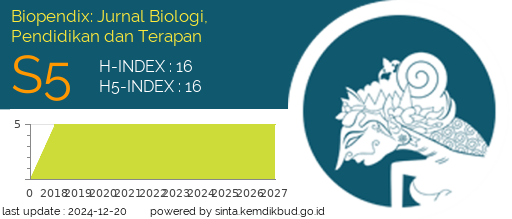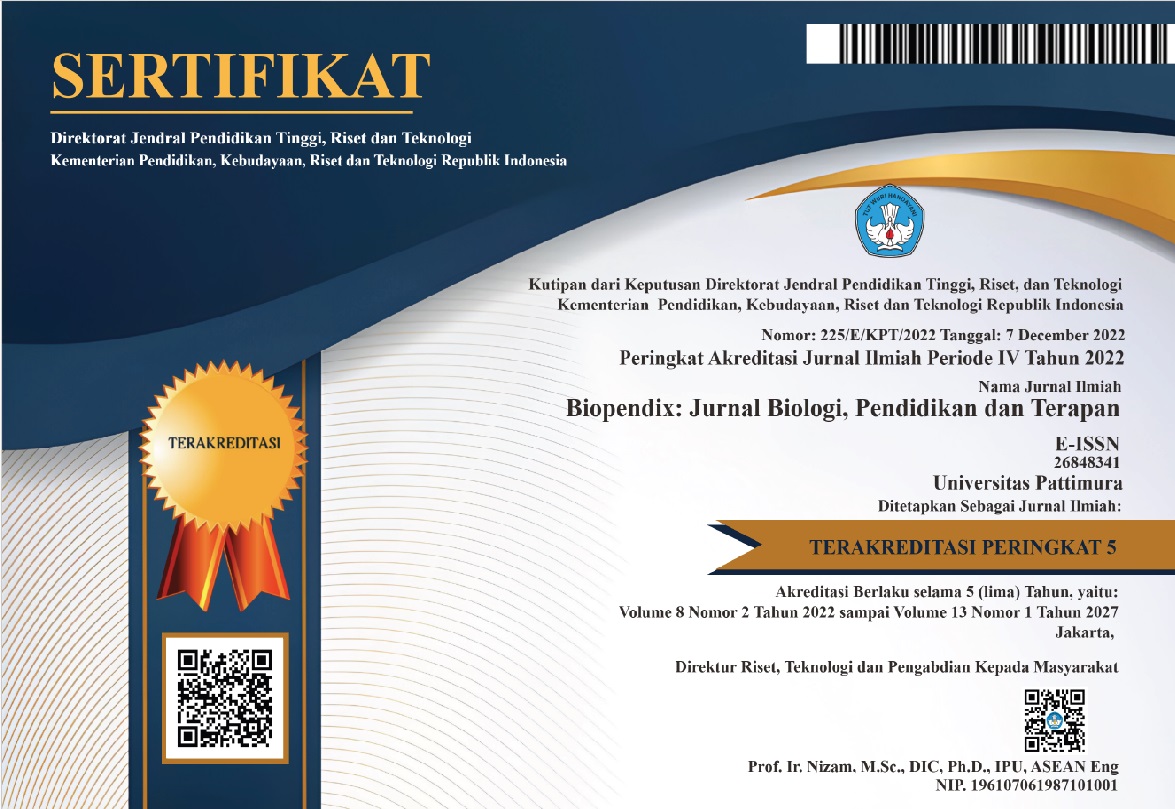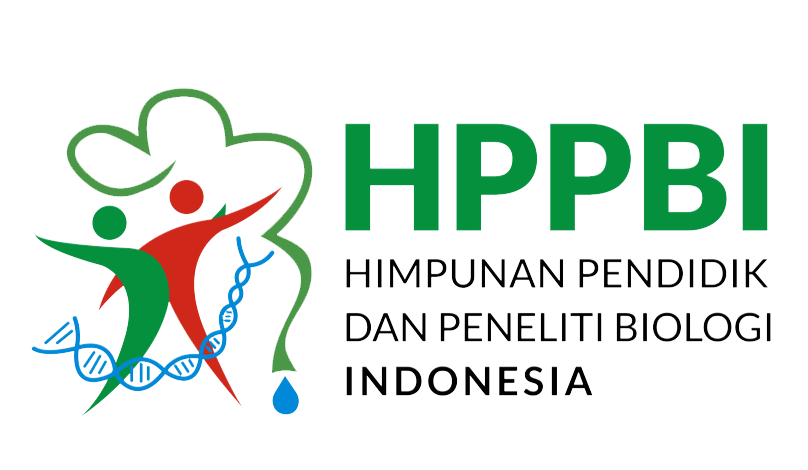ANALISIS KADAR ABU PADA SALAK MERAH (Salacca edulis) DI DESA RIRING DAN DESA BURIA KECAMATAN TANIWEL KABUPATEN SERAM BAGIAN BARAT, PROVINSI MALUKU
Abstract
Background: Indonesia is a country suitable for growing salak plants. With this good climate it is
possible for types of plants and fruit to continue to grow and develop properly. in 100g of salak fruit
flesh has a high nutritional content such as carbohydrates 20.9 g, calories 77.0 cal, protein 0.40 g,
calcium 28.00 mg, phosphorus 18.0 mg, iron 4.20 mg, vitamin B 0.04 mg, vitamin C 2.00 mg and
water 78.00 mg.
Methods: Testing the ash content using the dry ashing method. Ash content can show the total
minerals in a food ingredient.
Results: The results showed that there was a difference between the ash content of red salak fruit
in buria village and riring village. For Buria Village, the ash content of red salak fruit is 1.79535%. As
for Riring Village, the percentage of ash content is 2.4744%.
Conclusion: There are differences between the two samples of red salak fruit taken from 2 different
locations. The effect of altitude is mainly related to plant metabolic processes, such as biochemical
processes and the synthesis of secondary metabolites, such as vitamins and minerals which affect
the size of the ash content in fruit.
Downloads
References
Ago, A.Y., Wirawan, W dan Santoso, B. 2014. Pembuatan yogurt dari kulit pisang ambon serta keayakan usaha (Pengaruh jenis dan konsentrasi bahan penstabil). Jurnal Fakultas Partanian, Vol. 2, No. 2, Hal. 1-15.
Almatsier, S. 2006. Prinsip Dasar Ilmu Gizi. Jakarta: PT Gramedia Pustaka Utama
Anarsis, W. 1996. Agribisnis Komoditas Salak. Jakarta: Bumi Aksara
AOAC. 1995. Official Methods of Analysis. Associationof Official Analytical Chemists, Washington, D. C.
Arikunto, S. 2006. Prosedur Penelitian Suatu Pendekatan Praktek. Jakarta: PT. Rineka Cipta.
Arziyah, D., Yusmita, L., dan Ariyetti, A. 2019. Analisis mutu tahu dari beberapa produsen tahu di Kota Padang. Jurnal Teknologi Pertanian Andalas Vol. 23, No.2, Hal. 143-148.
Asrina, J., dan Fadilah, R. 2021. Kualitas keripik salak (Salacca zalacca) pada berbagai variasi temperatur dan waktu selama penggorengan hampa udara. Jurnal Pendidikan Teknologi Pertanian, Vol. 7, No. 1, Hal. 67–78.
Baihaqqi, S. F. 2017. Pengaruh macam dan konsentrasi zat pengatur tumbuh terhadap keberhasilan pencangkokakan salak ngulumut. Prodi Agroteknologi Fakultas Pertanian Universitas PGRI Yogyakarta.
Darma, W., dan Marpaung, M. P. 2020. Analisis jenis dan kadar saponin ekstrak akar kuning (Fibraurea chloroleuca Miers) secara gravimetri. Jurnal Pendidikan Kimia dan Ilmu Kimia, Vol., 3, No. 1, Hal. 51-59 .
Elly, S. S., Watuguly, T. W., dan Rumahlatu, D. 2018. Genetic diversity of salacca edulis from west seram district, Maluku, Indonesia based on morphological characters and RAPD profiles. Biodiversitas, Vol. 19, No. 5, Hal. 1777–1782.
Fauzi, M., 2006. Analisa Pangan dan Hasil Pertanian, Jember: FTP UNEJ
Hadiati, S., Susiloadi A., dan Budiyati T. 2008. Hasil persilangan dan pertumbuhan beberapa genotipe salak. Buletin Plasma Nutfah, Vol. 14, No. 1, Hal. 26-32 .
Harahap, S. S. 2011. Analisa Kritis Atas Laporan Keuangan. Jakarta: Rajawali Pers.
Herman, H., Rusli, R., Limu, E., Hamid, R., Haeruddin. 2011. Analisis kadar mineral dalam abu buah Nipa (Nypapa fructicans) Kaliwangi, Kendari, Sulawesi Tenggara. Jurnal Farmasi dan Kimia. Vol.1, No.2, Hal. 104-110
Herawati, W., dan Yayu, W. 2010. Analisis fenetik beberapa varietas kedelai berdasarkan karakteristik morfologi dan anatomi (Makalah seminar nasional hari lingkungan hidup dengan tem pengelolaan sumber daya alam dan lingkungannya berbasis kearifan lokal). PPLH Unsoed.
Hutomo, H. D., Swastawati, F., dan Rianingsih, L. 2015. Pengaruh konsentrasi asap cair terhadap kualitas dan kadar kolestrol belut (Monopterus albus) Asap. Jurnal Pengolahan dan Bioteknologi Hasil Perikanan, Vol. 4, No. 1, Hal. 7-14.
Kusumaningrum, R., Supriadi, A. dan Hanggita, S.R.J. 2013. Karakteristik dan mutu teh bunga lotus (Nelumbo nucifera). Jurnal Fishtech, Vol. 2, No. 1 Hal. 9-21.
Liu, K. 2019. Effects of sample size, dry ashing temperature and duration on determination of ash content in algae and other biomass. Algal Research, Vol. 40, Hal. 1-5.
Mandiri, T. K. 2010. Pedoman Budidaya Buah Salak. Bandung: CV Nuansa Aulia.
Muhdi. 2004. Pengaruh elevasi terhadap pertumbuhan dan kualitas kayu. Program Ilmu Kehutanan, Fakultas Pertanian, Universitas Sumatra Utara, Medan.
Nandariyah., Soemartono., Artam., dan Taryono. 2004. Keragaman kultivar salak (Salacca zalacca). Agrosains, Vol. 6, No. 2, Hal. 75-79.
Nursalam, S. 2013. Metodologi Penelitian Ilmu Keperawatan Pendekatan Praktis. Jakarta: Salemba Medika.
Núñez, P.A., Pimentel, A., Almonte, I., Sotomayor-Ramírez, D., Martínez, N., Pérez1, A., & Céspedes1, C.M. 2011. Soil fertility evaluation of coffee (Coffea spp.) production systems and management recommendations for the Barahona Province, Dominican Republic. Journal of Soil Science and Plant Nutrition, Vol. 11, No.1, Hal. 127–140.
Latulake, P 2021. Dampak budidaya salak merah terhadap kondisi kesejahteraan keluarga (Studi Di Negeri Riring Kecamatan Taniwel Kabupaten Seram Bagian Barat). Skripsi UKIM Ambon.
Purnomo, H. 2001. Budidaya Salak Pondoh. Semarang: Aneka Ilmu.
Pattinama M. J., Boreel A, Laisina J.K.J., Leimena H.E.P. 2007. The ethnobotany of kenari (Canarium indicum L) and salak (Salacca zalacca var Amboinensis) commodities to strengthen the bargaining position of the economy as well as efforts to enhance the food security program for Alune society in Seram Island. Universitas Pattimura, Ambon.
Ping, C., Gary, J., Michaelson, Cynthia, A., Stiles, & González, G. (2013). Carbon stores, oil characteristics, and nutrient distribution in eight forest types along an elevation gradient, eastern Puerto Rico. Ecological Bulletins, No.54, Hal.67–86.
Rai, I. N., Wiraatmaja, I. W., Semarajaya, C. G. A., Astawa, I. N. G., Sukewijaya, I. M., Mayadewi, N. A., dan Wijana, G. 2015. Pelatihan penerapan teknologi irigasi tetes sederhana untuk memproduksi buah salak gula pasir di luar musim. Buletin Udayana Mengabdi, Vol. 14, No. 1, Hal. 46-50.
Rina, Y .2015. Metode Analisis Pangan dan Komponen Bioaktif. Andalas University Pres.
Romelan, M. P. 2018. Analisis jenis dan kadar saponin ekstrak metanol daun kemangi (Ocimum basilicum L.) dengan menggunakan metode gravimetri. Jurnal Farmasi Lampung , Vol. 07, No.2, Hal. 81-86 .
Roni, M. A. 2008. Formulasi minuman herbal instan antioksidan dari campuran teh hijau (Camellia sinensis), pegagan (Centella asiatica), dan daun jeruk purut (Cytus hystrix), Skripsi, Institut Pertanian Bogor.
Saeed, S., Barozai, M.Y.K., Ahmad, A., & Shah, S.H. 201). Impact of altitude on soil physical and chemical properties in Sra Ghurgai (Takatu mountain range) Quetta, Balochistan. International Journal of Scientific & Engineering Research, Vol. 5, No. 3, Hal. 730–735.
Schuiling , D.L. dan Mogea, J.P. 1992. Plant Resources of South-East Asia. Edible Fruits and Nuts. Prosea Bogor Indonesia. Vol.2, Hal. 278-284.

Authors who publish with BIOPENDIX: Jurnal Biologi, Pendidikan dan Terapan agree to the following terms:
- Authors retain copyright and grant the journal right of first publication with the work simultaneously licensed under Creative Commons Atribution-ShareAlike 4.0 International License (CC BY-SA 4.0) that allows others to share the work with an acknowledgment of the work's authorship and initial publication in this journal.
- Authors are able to enter into separate, additional contractual arrangements for the non-exclusive distribution of the journal's published version of the work (e.g., post it to an institutional repository or publish it in a book), with an acknowledgment of its initial publication in this journal.
- Authors are permitted and encouraged to post their work online (e.g., in institutional repositories or on their website) prior to and during the submission process, as it can lead to productive exchanges, as well as earlier and greater citation of published work.




 2
2






